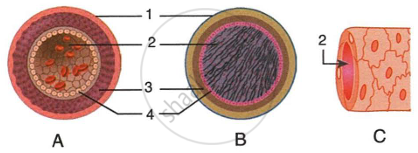Advertisements
Advertisements
प्रश्न
The figures given below show diagrammatic cross sections of three kinds of blood vessels.
 |
- Identify the blood vessels A, B and C.
- Name the parts labelled 1-4.
- Mention two structural differences between A and B.
- Name the kinds of blood that flow through A and through B respectively.
- In which one of the vessels referred to in (a) above does the exchange of gases actually take place?
उत्तर
- A - Artery, B - Vein, C - Capillary
-
- Tunica Externa
- Lumen
- Tunica media
- Endothelium
- An artery has thick muscular walls and a narrow lumen. It does not have any valve.
A vein, on the other hand, has thin muscular walls and a wider lumen. It has valves to prevent backflow of blood. - A (Artery) - oxygenated blood, B (Vein) - deoxygenated blood.
- At the capillary level, the actual exchange of gases takes place.
APPEARS IN
संबंधित प्रश्न
Put a tick mark (✓) against the correct alternative in the following statement:
Blood Capillary is a
- Broad tube
- Artery with thick wall
- Vein with large lumen
- Narrow tube made up of endothelium only.
Differentiate between the following pair of terms:
RBC and WBC.
Describe the functions of Blood.
Define the term Arteries.
Complete the following sentence with appropriate word:
The blood vessel leaving the left ventricle of the mammalian heart is the _________.
The circulatory system is made up of the heart, blood, and blood vessels.
Which of the following blood vessels carry oxygenated blood from lungs to heart?
Analogy:
Carries blood from the right ventricle to lungs: Pulmonary artery.
Carries blood from the lungs to left atrium: ______.
Analogy:
Carry oxygenated blood: Arteries.
Carry deoxygenated blood: ______.
Distinguish between the following pair on the basis of words indicated in the bracket ( ):
Arteries and Veins (Wall and lumen)
